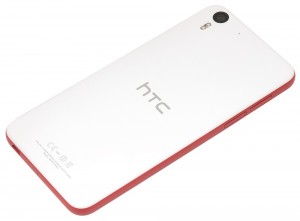HTC’s crafted one of the best midrange phones on the market with its new Desire Eye, a playful device that’s just as, if not more technically advanced than its flagship One (M8). Its potent Snapdragon 801 chipset, gorgeous 5.2-inch 1080p display, and stylish water- and dust-resistant body would be big draws on their own, but are actually secondary to the Desire Eye’s most compelling feature – a big and powerful 13-megapixel front-facing camera. And that’s not to mention the above-average shooter on its back.
There are still enough flaws here to remind you why this is a midrange device in the first place, but the Desire Eye is a hard handset to ignore if you love snapping selfies. Let’s dig deeper into the AT&T exclusive, which is now available for $450 unlocked or $70 with a two-year contract.
Build and Design
The Desire Eye is entirely made of plastic outside of its front, which is fully coated in Gorilla Glass 3. It comes in several color schemes, with the rim always contrasting with the back, giving the phone a playful and youthful look. This kind of color may be off-putting to some, but since this is a midrange device, it’s understandable that HTC is willing be a little more outlandish here than it’d be with a hero device like the One.
That’s not to say the Desire Eye feels cheap, though. Like the One, it features a unibody construction, which is rare for a phone with this much plastic. The negative here is that this makes the phone’s battery impossible to remove, but the sturdiness of the build makes that sacrifice easier to swallow. That, and the fact that it allows the phone to be dunked underwater without harm for up to 30 minutes. It’s clear that HTC went into this with the idea of making a plastic phone that’s more aesthetically pleasing than pragmatic, and it’s mostly succeeded in that regard.
Still, you’ll need big hands for this to feel fully comfortable. With a 5.2-inch display, dimensions of 151 x 74 x 8.5 mm (9.97 x 2.91 x 0.33 in), and a weight of 154 grams (5.43 oz.), you likely won’t be able to use the device with one hand. We can’t knock HTC too hard for this given that almost every phone feels supersized nowadays, but a phone made for taking selfies should be more accessible.
The front of the phone, just above the screen, includes the front-facing 13-megapixel camera, the phone’s titular “eye” and most immediately striking feature. It also has a dual-LED flash with a set of the usual sensors. As with most recent HTC phones, there’s an unfortunately huge bezel below the display, which features the infamous HTC logo bar. The capacitive Back, Home, and Tasks keys take up space on the actual display on top of that – a design choice dictated by Android, sure, but a nuisance on this particular device nonetheless. Other 5.2-inch phones like the Moto X has been less wasteful with their real estate, so it’s becoming harder to justify HTC’s insistence on chewing up so much room around its displays.
The back side includes the phone’s second eye, the 13-megapixel rear camera, along with another dual-LED flash and a secondary microphone for reducing ambient noise. One noteworthy design plus here is that both cameras have been physically fused with the front and back, which further protects them from possible damage caused by dragging the phone across a table or other hard surfaces.
The top of the phone includes a 3.5 mm audio jack, while the bottom houses the microUSB slot and primary microphone. The left side features covered microSD and nanoSIM card slots, while the right includes the Power key, volume rocker, and a dedicated camera key, which turns the camera on from standby in impressive time. These keys are a little too shallow to press, but they never become too much of an annoyance in practice.
Display
The Desire Eye comes with a 5.2-inch Full HD IPS display, resulting in a respectable pixel density of 424 ppi. The panel is very much similar to that of the One (M8), so it shouldn’t be surprising to hear that it’s generally excellent. It’s consistently sharp and exceptionally bright, with lively colors and enduring quality in direct sunlight. It wouldn’t be a stretch to call this a flagship-level screen, which is refreshing to see in a phone of this price.
If there’s any shortcoming here, it’s that darker colors could stand to be a bit fuller. This is an IPS screen, not an OLED one, so while whites here are wonderfully bright and clean, black tones are rather light, sometimes looking closer to grey than anything else. Photos or video clips taken in darker rooms and games with darker designs will seem paler than they actually are, which doesn’t ruin things but could understandably be problem for perfectionists.


